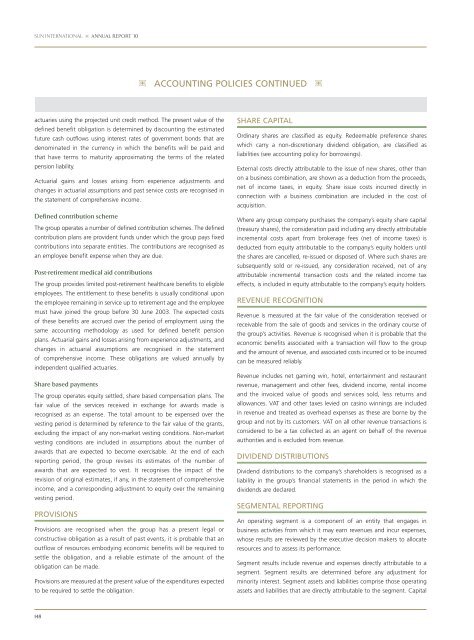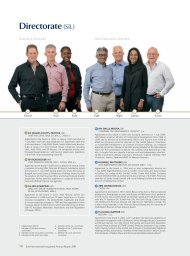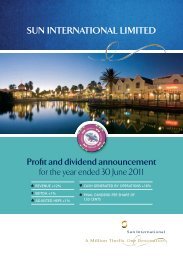PDF 25 MB - Sun International | Investor Centre
PDF 25 MB - Sun International | Investor Centre
PDF 25 MB - Sun International | Investor Centre
Create successful ePaper yourself
Turn your PDF publications into a flip-book with our unique Google optimized e-Paper software.
SUN INTERNATIONAL ANNUAL REPORT ’10<br />
actuaries using the projected unit credit method. The present value of the<br />
defined benefit obligation is determined by discounting the estimated<br />
future cash outflows using interest rates of government bonds that are<br />
denominated in the currency in which the benefits will be paid and<br />
that have terms to maturity approximating the terms of the related<br />
pension liability.<br />
Actuarial gains and losses arising from experience adjustments and<br />
changes in actuarial assumptions and past service costs are recognised in<br />
the statement of comprehensive income.<br />
Defined contribution scheme<br />
The group operates a number of defined contribution schemes. The defined<br />
contribution plans are provident funds under which the group pays fixed<br />
contributions into separate entities. The contributions are recognised as<br />
an employee benefit expense when they are due.<br />
Post-retirement medical aid contributions<br />
The group provides limited post-retirement healthcare benefits to eligible<br />
employees. The entitlement to these benefits is usually conditional upon<br />
the employee remaining in service up to retirement age and the employee<br />
must have joined the group before 30 June 2003. The expected costs<br />
of these benefits are accrued over the period of employment using the<br />
same accounting methodology as used for defined benefit pension<br />
plans. Actuarial gains and losses arising from experience adjustments, and<br />
changes in actuarial assumptions are recognised in the statement<br />
of comprehensive income. These obligations are valued annually by<br />
independent qualified actuaries.<br />
Share based payments<br />
The group operates equity settled, share based compensation plans. The<br />
fair value of the services received in exchange for awards made is<br />
recognised as an expense. The total amount to be expensed over the<br />
vesting period is determined by reference to the fair value of the grants,<br />
excluding the impact of any non-market vesting conditions. Non-market<br />
vesting conditions are included in assumptions about the number of<br />
awards that are expected to become exercisable. At the end of each<br />
reporting period, the group revises its estimates of the number of<br />
awards that are expected to vest. It recognises the impact of the<br />
revision of original estimates, if any, in the statement of comprehensive<br />
income, and a corresponding adjustment to equity over the remaining<br />
vesting period.<br />
PROVISIONS<br />
Provisions are recognised when the group has a present legal or<br />
constructive obligation as a result of past events, it is probable that an<br />
outflow of resources embodying economic benefits will be required to<br />
settle the obligation, and a reliable estimate of the amount of the<br />
obligation can be made.<br />
Provisions are measured at the present value of the expenditures expected<br />
to be required to settle the obligation.<br />
148<br />
ACCOUNTING POLICIES CONTINUED<br />
SHARE CAPITAL<br />
Ordinary shares are classified as equity. Redeemable preference shares<br />
which carry a non-discretionary dividend obligation, are classified as<br />
liabilities (see accounting policy for borrowings).<br />
External costs directly attributable to the issue of new shares, other than<br />
on a business combination, are shown as a deduction from the proceeds,<br />
net of income taxes, in equity. Share issue costs incurred directly in<br />
connection with a business combination are included in the cost of<br />
acquisition.<br />
Where any group company purchases the company’s equity share capital<br />
(treasury shares), the consideration paid including any directly attributable<br />
incremental costs apart from brokerage fees (net of income taxes) is<br />
deducted from equity attributable to the company’s equity holders until<br />
the shares are cancelled, re-issued or disposed of. Where such shares are<br />
subsequently sold or re-issued, any consideration received, net of any<br />
attributable incremental transaction costs and the related income tax<br />
effects, is included in equity attributable to the company’s equity holders.<br />
REVENUE RECOGNITION<br />
Revenue is measured at the fair value of the consideration received or<br />
receivable from the sale of goods and services in the ordinary course of<br />
the group’s activities. Revenue is recognised when it is probable that the<br />
economic benefits associated with a transaction will flow to the group<br />
and the amount of revenue, and associated costs incurred or to be incurred<br />
can be measured reliably.<br />
Revenue includes net gaming win, hotel, entertainment and restaurant<br />
revenue, management and other fees, dividend income, rental income<br />
and the invoiced value of goods and services sold, less returns and<br />
allowances. VAT and other taxes levied on casino winnings are included<br />
in revenue and treated as overhead expenses as these are borne by the<br />
group and not by its customers. VAT on all other revenue transactions is<br />
considered to be a tax collected as an agent on behalf of the revenue<br />
authorities and is excluded from revenue.<br />
DIVIDEND DISTRIBUTIONS<br />
Dividend distributions to the company’s shareholders is recognised as a<br />
liability in the group’s financial statements in the period in which the<br />
dividends are declared.<br />
SEGMENTAL REPORTING<br />
An operating segment is a component of an entity that engages in<br />
business activities from which it may earn revenues and incur expenses,<br />
whose results are reviewed by the executive decision makers to allocate<br />
resources and to assess its performance.<br />
Segment results include revenue and expenses directly attributable to a<br />
segment. Segment results are determined before any adjustment for<br />
minority interest. Segment assets and liabilities comprise those operating<br />
assets and liabilities that are directly attributable to the segment. Capital










